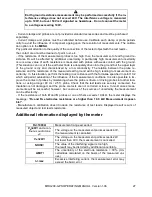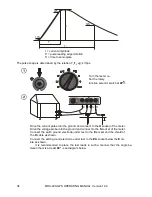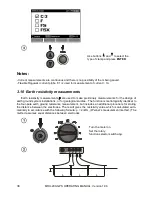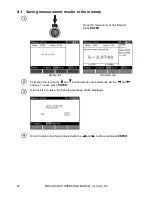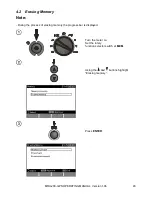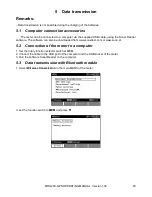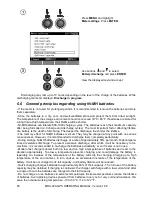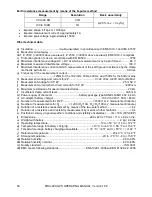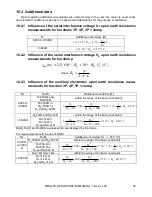
MRU-200-GPS OPERATING MANUAL Version 1.06
41
- Calculations are based upon the assumption that the distance between the measurement elec-
trodes are equal (
Wenner’s method). If this is not the case, the earth ground resistance measurement
must be perfomed by the four-pole method, and calculations must be performed individually.
Pay particular attention to the quality of the connection of the tested object with the test leads
–
the contact area must be cleaned of paint, rust, etc.
- If the resistance of the measurement probes is too high, then the measurement of earth ground re-
sistance R
E
will be affected by additional uncertainty. A particularly high measurement uncertainty
occurs a low value of earth resistance is measured with probes with weak contact with the ground.
(This situation can occur if the earth electrode is adequately driven into the ground but the upper layer
of the ground is dry and characterized by a low conductivity. The relation between the probe re-
sistance and the resistance of the measured earth ground will be high, leading to measurement un-
certainty. In this situation, perform the testing in accordance with the formulae specified in point 10.2
which will permit evaluation of the influence of the measurement conditions. It is also possible to im-
prove the contact of probes by moistening where the probe is driven, or driving probes into other loca-
tions, or using a longer 80 cm / 2.5 ft. probe. Check that the test leads are securely connected, the
insulation is not damaged, and the probe contacts are not corroded or loose. In most cases meas-
urements will be successful; however, be conscious of the sources of uncertainty the measurement
can be affected by.
- If the resistance of
H
and
S
probes or one of them exceeds 19,9k
Ω, an appropriate message is dis-
played: "
R
H
and R
S
electrodes resistance are higher than 19.9 kΩ! Measurement impossible!
".
Additional information displayed by the meter
ρ >999kΩm
Measurement range exceeded.
V
N
>40V!
and a con-
tinuous audio tone.
The voltage on the measurement points exceeds 40V,
the measurement is cancelled.
V
N
>24V!
The voltage on the measurement points exceeds 24V
but lower than 40V, the measurement is cancelled.
LIMIT!
The uncertainty of the electrode resistance > 30%. (Un-
certainties calculated on the basis of the measured val-
ues)
NOISE
!
The value of the interfering signal is too high,
the result may be distorted by additional uncertainty.
4
Memory
The MRU-200-GPS meters are equipped with a memory to store up to 990 results of resistance
measurements. Individual measurements are saved in memory cells. The memory is divided into 10
banks of 99 cells each. Each result may be saved in a cell of a defined number, and in a selected
bank. The user may assign numbers of the cells to individual measurement points, and the numbers
of the banks to individual objects, perform measurements in any order, and repeat them without los-
ing other data.
The memory is not deleted when the meter is turned off, so results may be saved and reviewed
at a later time, or transmitted to a computer.
It is good practice to delete the memory before a new series of measurements is performed,
making sure that before memory is erased the data has been reviewed and retained if necessary,
usually by saving on a computer.

